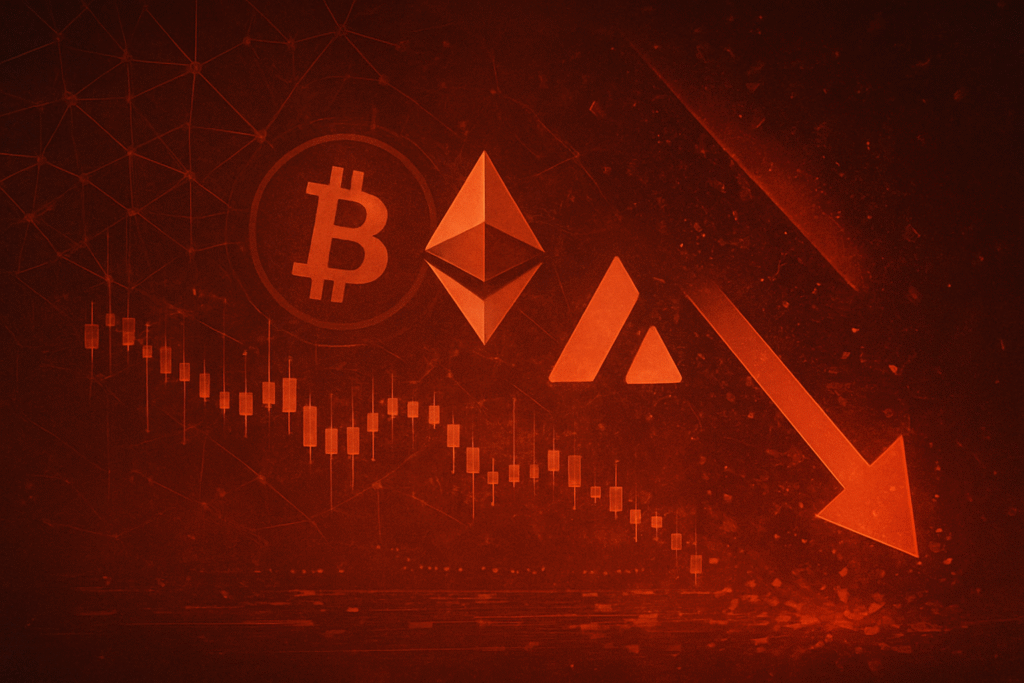
November 14, 2025 – The cryptocurrency market is currently engulfed in a pervasive "extreme fear" sentiment, marked by significant price declines across most major digital assets and widespread investor apprehension. As of November 14, 2025, the global cryptocurrency market capitalization has contracted, reflecting a strong "risk-off" environment that has seen some large cryptocurrencies, like Avalanche (AVAX), shed considerable value, while others struggle for resilience or post minor gains. This period of uncertainty, largely driven by macroeconomic headwinds and a reduction in Federal Reserve interest rate cut expectations, has triggered substantial liquidation events and sparked intense debate within the crypto community regarding the market's immediate future.
The immediate market reaction has been characterized by widespread panic, with over $1.10 billion in liquidations occurring in the past 24 hours, disproportionately affecting long positions. This volatile environment underscores the fragility of investor confidence and the heightened sensitivity of digital assets to external economic pressures. For the broader crypto ecosystem, this downturn is a critical test, pushing projects and investors to re-evaluate strategies and focus on fundamental value amidst the prevailing fear.
Market Impact and Price Action
The current market landscape on November 14, 2025, is overwhelmingly bearish, with 96 out of the top 100 cryptocurrencies experiencing declines. The prevailing sentiment is one of "extreme fear," with the Crypto Fear & Greed Index plummeting to as low as 15, its lowest point since February 2025. This downturn is largely attributed to macroeconomic uncertainties, including higher Treasury yields, a strong US dollar, and reduced expectations for a Federal Reserve interest rate cut in December.
Bitcoin (BTC), the market leader, has seen a 6.2% decrease, trading around $97,033, and has repeatedly fallen below the critical $100,000 mark this month. Bitcoin spot ETFs have experienced substantial outflows, totaling $869.86 million on Thursday, signaling institutional deleveraging. Its 24-hour trading volume surged by 55% to $104.72 billion, indicating intense selling pressure. Key support levels are identified at $97,000 and $94,500, with resistance at $100,000 and $101,000. On-chain data reveals long-term BTC holders offloading 815,000 BTC ($79 billion) in 30 days, the largest sell-off since January 2024.
Ethereum (ETH) has fared worse, dropping 9.2% to $3,208. It is down 22.2% in the past month and 35.1% from its all-time high. Ethereum ETFs also recorded significant outflows of $259.72 million. Its daily trading volume surged by 48% to $822.63 trillion. While a rebound to $3,500 is possible, a retreat below $3,000 is also being considered, with support at $3,200 and $3,000, and resistance at $3,350-$3,400. Whales, however, have accumulated nearly 460,000 ETH (over $1.6 billion) in the past four days, hinting at a potential re-emergence of confidence.
Avalanche (AVAX), a notable underperformer, is trading at $15.95, experiencing an 8.8% decline in the last 24 hours. Its market capitalization stands at $6.84 billion. The 24-hour trading volume for AVAX saw a significant spike, reaching approximately $637.29 million, reflecting strong market participation amid heightened volatility. Technical analysis indicates a bearish setup, with AVAX trading below its key moving averages. On-chain data reveals a consistent selling pressure, with approximately $4.18 million in net outflows on November 14. The Relative Strength Index (RSI) is hovering around 37, suggesting oversold conditions are approaching, but momentum remains weak. Critical support lies at $15.50, with resistance near $17.50.
Solana (SOL) is down 8.6% to $142, marking its third consecutive week of losses. User engagement on the Solana network has hit a 12-month low, with daily active addresses dropping by 63%. Support is at $140, with resistance at $148. The FTX/Alameda bankruptcy estate continues to release tokens, adding selling pressure.
XRP (XRP) has declined by 8.41% to $2.2894, facing what is described as "one of the most fearful moments of 2025." This comes despite the debut of Canary Capital's XRPC, the first US spot XRP ETF, which garnered $58 million in trading volume on Thursday, followed by a "sell-the-news" reaction. Key support is at $2.30, with resistance at $2.40.
Cardano (ADA) remains close to $0.50, down 8.56% to $0.5179, with a bearish bias and a 3% loss this week. Whale selling of 140 million ADA tokens over two weeks has exacerbated downward pressure. Support is at $0.52, with resistance at $0.60.
BNB fell by 4.72% to $916.91, losing the support at $1,000, which now acts as resistance. Support is at $900, with resistance at $1,000.
Tron (TRX) stands out as one of the few cryptocurrencies showing some resilience, with a comparatively smaller decline of 2.3% to $0.2927. Support is around $0.281, with resistance near $0.30.
This market downturn shares several characteristics with past crypto bear regimes, including macroeconomic factors as catalysts, weakening institutional demand (despite some accumulation), liquidation cascades, and a shift in retail sentiment to "extreme fear." Altcoins are generally underperforming Bitcoin, a common trend during such corrections.
Community and Ecosystem Response
The crypto community's response to the November 2025 market downturn is a complex blend of frustration, panic, and a cautious search for stability, all unfolding against a backdrop of "extreme fear." Social media platforms like Crypto Twitter and Reddit are rife with discussions reflecting this anxiety, although an underlying "HODL" (Hold On for Dear Life) mentality persists among long-term investors.
The Crypto Fear & Greed Index, plummeting to as low as 15, vividly illustrates the widespread pessimism. Discussions around Bitcoin (BTC) are now evenly split between bullish and bearish views, a stark contrast to typical sentiment. While many retail investors share stories of devastating liquidations and speculate about "whale manipulation," a segment of the community maintains optimism, advocating for "buying the dip" and viewing the downturn as a "healthy reset." Reddit threads on r/ethereum and general crypto subreddits show frustration and a sense of a "dead" market, with users questioning the future of altcoins and expressing weariness over the continuous downtrend.
Crypto influencers and thought leaders are largely echoing concerns about market stability, emphasizing the risks of excessive leverage. Veteran voices like "CryptoSage" are advising followers to "zoom out" and view the dip as a potential buying opportunity, while "BlockchainBabe" promotes dollar-cost averaging. However, figures like Robert Kiyosaki, author of "Rich Dad Poor Dad," have warned of a "massive crash" in global financial markets, even as he positions Bitcoin and Ethereum as "generational opportunities." Many influencers are highlighting macroeconomic factors, such as the need for falling interest rates, as crucial for reigniting risk appetite.
The market downturn has had tangible effects across the broader crypto ecosystem. The Decentralized Finance (DeFi) sector has experienced a notable drop in Total Value Locked (TVL), with users withdrawing liquidity or facing liquidations. Major exploits, such as the Balancer protocol hack (November 3, 2025) resulting in $128.6 million in stolen assets, and Stream Finance's xUSD stablecoin collapse, have sent "shockwaves through the crypto community," renewing concerns about smart contract security. Despite these setbacks, some DeFi projects are showing an uptick in user activity, with BNB Chain, Solana, and Arbitrum leading growth among DeFi ecosystems. Stablecoin activity has surged as investors seek safety, with the total stablecoin market capitalization rising.
The NFT market, already in a prolonged downturn since 2023-2024, has seen "further decreases in trading volume and floor prices." Global NFT marketplace revenues are projected to plunge by $75 million or 11% year-over-year in 2025. In contrast, Web3 gaming has shown notable resilience, accounting for 27.9% of all unique active wallets in the decentralized application (DApp) ecosystem, pulling in over 4.5 million daily active wallets, a 1% increase from September. This success is attributed to innovation and improved customer experiences, suggesting that practical utility can help segments of the Web3 space weather market volatility.
What's Next for Crypto
The current market downturn, while challenging, is viewed by many as a natural part of market cycles that can lead to long-term maturation and structural shifts within the crypto ecosystem. In the short term, continued volatility and price pressure are expected, with liquidation risks remaining high. The market remains fragile, and a breach of key support levels, such as Bitcoin's $98,000 zone, could lead to further declines. However, some technical indicators, like the Relative Strength Index (RSI) dipping to 35, historically suggest increased technical buying activity, hinting at potential relief rallies.
Long-term implications point towards a maturation of the asset class, with an increasing pivot towards real-world utility, driven by growing institutional adoption, stablecoin development, and the tokenization of assets. Downturns tend to "clean up" speculative projects, shifting focus to those with robust architecture and verifiable development progress. The continued influx of institutional capital, partly facilitated by approved spot Bitcoin ETFs in the U.S. and similar products globally, is expected to bring greater stability and legitimacy. Analysts forecast the total crypto market cap could reach $5 trillion to $7.5 trillion by the end of 2025, with Bitcoin potentially reaching $200,000.
Several potential catalysts could drive future recovery and sustained growth. Macroeconomic shifts, such as a continuation of falling interest rates by central banks and the cessation of quantitative tightening (e.g., projected for December 1, 2025), could divert more capital into riskier assets. Regulatory developments, particularly the establishment of clear and comprehensive frameworks in major economies, will reduce uncertainty and encourage broader adoption. Continued strong inflows into spot Bitcoin and potential Ethereum ETFs signify growing institutional demand. Furthermore, technological advancements like Ethereum's scalability solutions, improved interoperability, and the expansion of DeFi and Real-World Asset (RWA) tokenization are crucial for demonstrating practical utility beyond speculation. The emergence of AI agents in the crypto space is also a development to watch for 2025.
For investors, strategic considerations include maintaining calm, avoiding emotional decisions, and employing dollar-cost averaging (DCA). Diversifying portfolios across blue-chip cryptocurrencies like Bitcoin and Ethereum, focusing on projects with strong fundamentals, and robust risk management are crucial. Projects, on the other hand, should prioritize utility, sustainable tokenomics, regulatory compliance, and consistent development to weather market volatility and attract long-term investment.
Possible scenarios include a moderately bullish outlook (medium-high likelihood) driven by institutional adoption and regulatory clarity, a gradual recovery and consolidation phase (medium likelihood), or a volatile sideways/corrective market (medium likelihood) if macroeconomic headwinds persist. An extended bear market or regulatory crackdown is considered a low likelihood given current trends towards adoption and integration.
Bottom Line
The cryptocurrency market, as of November 14, 2025, is navigating a period of significant volatility and "extreme fear," yet it simultaneously signals a profound maturation of the industry. For crypto investors and enthusiasts, the key takeaway is the resilience of underlying fundamentals and the accelerating pace of institutional integration, even amidst short-term price corrections. While the market is experiencing a "risk-off" rotation, long-term investors are observed to be accumulating, suggesting a strategic repositioning rather than a complete capitulation.
The long-term significance of the current market environment lies in its role as a crucible, refining the industry and weeding out speculative excesses. The increasing embrace of stablecoins as core financial infrastructure, the rise of AI and crypto integration, and the burgeoning trend of Real-World Asset (RWA) tokenization are not merely fleeting trends but fundamental shifts that are solidifying crypto's place in the global financial landscape. These developments point towards a future where digital assets are not just speculative instruments but integral components of everyday finance, driving efficiency and democratizing access.
Final thoughts on crypto adoption suggest an accelerated trajectory. Financial institutions are no longer on the sidelines but are actively engaging with crypto, building trading desks and piloting blockchain programs. Stablecoins are upgrading legacy payment systems, and the integration of AI alongside RWA tokenization is creating new, tangible use cases that will draw a wider audience. While consumer-focused Central Bank Digital Currencies (CBDCs) see reduced interest, wholesale CBDCs for institutional settlement are gaining momentum, indicating a continued transformation of financial markets. This phase is expected to onboard billions of users through innovative consumer products, further cementing crypto's role in the global financial ecosystem.
Important dates, events, and metrics to monitor include ongoing regulatory developments, particularly US market structure legislation and stablecoin regulation. Economic factors such as the US interest rate decision on December 10, 2025, and the global liquidity cycle will be crucial. Market metrics like the Crypto Fear & Greed Index and Bitcoin Dominance will offer insights into sentiment and market leadership. Upcoming industry events like the Digital Currency Conference Dubai (November 22-23, 2025) and Consensus Hong Kong (February 10-12, 2026) will provide platforms for innovation and networking. Specific project launches, such as Coinbase's token sales platform and the Digitap ($TAP) presale, along with continued developments in the Solana ecosystem, will also be key indicators of market health and growth.
This article is for informational purposes only and does not constitute financial or investment advice. Cryptocurrency investments carry significant risk.







